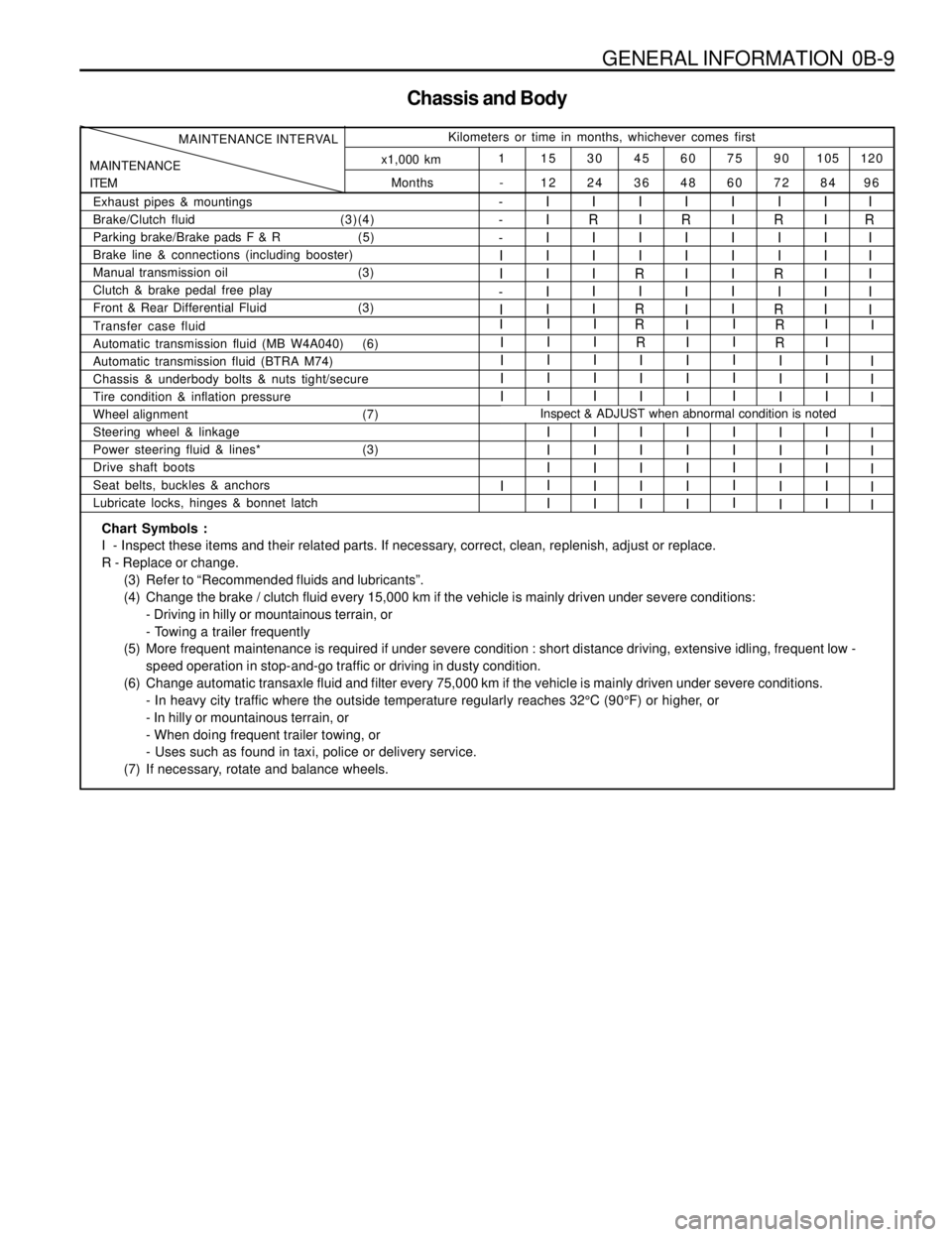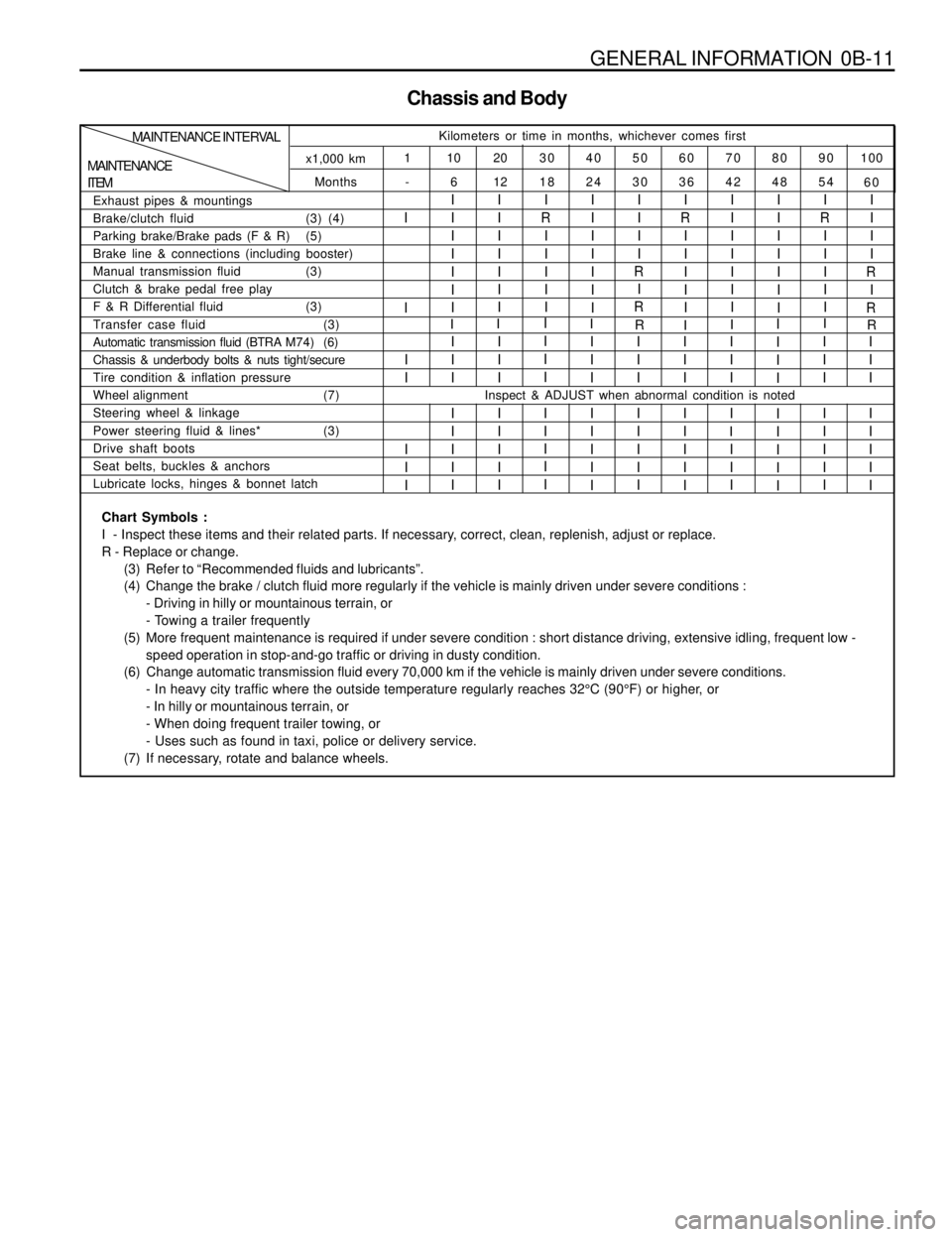boot SSANGYONG MUSSO 1998 Workshop Repair Manual
[x] Cancel search | Manufacturer: SSANGYONG, Model Year: 1998, Model line: MUSSO, Model: SSANGYONG MUSSO 1998Pages: 1463, PDF Size: 19.88 MB
Page 19 of 1463

GENERAL INFORMATION 0B-7
MAINTENANCE AND REPAIR
MAINTENANCE AND LUBRICATION
Fuel Filter Replacement
Replace the engine fuel filter every.
lGasoline Engine : 60,000km (36,000 miles)
lDiesel Engine : 45,000km (24,000 miles)
Spark Plug Replacement
Replace spark plugs with same type.
lType : BOSCH : F8DC4
BERU : 14F-8DU4
Champion : C11YCC
lGap : 0.8 ± 0.1 mm
Spark Plug Wire Replacement
Clean wires and inspect them for burns, cracks or other
damage. Check the wire boot fit at the Distributor and at
the spark plugs. Replace the wires as needed.
Brake System Service
Check the disc brake pads or the drum brake linings.
Check the pad and the lining thickness carefully.
Tire and Wheel Inspection and Rotation
Check the tires for abnormal wear or damage. To
equalize wear and obtain maximum tire life, rotate the
tires. If irregular or premature wear exists, check the
wheel alignment and check for damaged wheels. While
the tires and wheels are removed, inspect the brakes.
NORMAL VEHICLE USE
The maintenance instructions contained in the
maintenance schedule are based on the assumption
that the vehicle will be used for the following reasons:
lTo carry passengers and cargo within the limitation
of the tire inflation prassure. Refer to “Tire and Wheel”
in section 2E.
lTo be driven on reasonable road surfaces and within
legal operating limits.
EXPLANATION OF SCHEDULED
MAINTENANCE SERVICES
The services listed in the maintenance schedule are
further explained below. When the following maintenance
services are performed, make sure all the parts are
replaced and all the necessary repairs are done before
driving the vehicle. Always use the proper fluid and
lubricants.
Engine Oil and Oil Filter Change
Always use above the API SH grade or recommended
engine oil.
Engine Oil Viscosity
Engine oil viscosity (thickness) has an effect on fuel
economy and cold weather operation. Lower viscosity
engine oils can provide better fuel economy and cold
weather performance; however, higher temperature
weather conditions require higher viscosity engine oils
for satisfactory lubrication. Using oils of any viscosity
other than those viscosities recommended could result
in engine damage.
Cooling System Service
Drain, flush and refill the system with new coolant. Refer
to “Recommended Fluids And Lubricants” in this section.
Air Cleaner Element Replacement
Clean the air cleaner element every.
lGasoline Engine : 15,000km (10,000 miles)
lDiesel Engine : 10,000km (6,000 miles)
Replace the air cleaner element every .
lGasoline Engine : 60,000km (36,000 miles)
lDiesel Engine : 30,000km (18,000 miles)
Replace the air cleaner more often under dusty
conditions.
Tire Rotation (Left - Hand Drive Type)
Page 21 of 1463

GENERAL INFORMATION 0B-9
Chassis and Body
Months
MAINTENANCE
ITEMMAINTENANCE INTERVALKilometers or time in months, whichever comes first
120 105 90 75 60 45 30 15 1
96 84 72 60 48 36 24 12
- x1,000 km
Exhaust pipes & mountings
Brake/Clutch fluid(3)(4)
Parking brake/Brake pads F & R (5)
Brake line & connections (including booster)
Manual transmission oil (3)
Clutch & brake pedal free play
Front & Rear Differential Fluid (3)I
R
I
I
I
I
I-
-
-
I
I
-
II
I
I
I
I
I
II
R
I
I
I
I
II
I
I
I
R
I
RI
I
I
I
I
I
II
R
I
I
R
I
RI
I
I
I
I
I
II
R
I
I
I
I
I
Automatic transmission fluid (MB W4A040) (6)
Automatic transmission fluid (BTRA M74)
Chassis & underbody bolts & nuts tight/secure
Tire condition & inflation pressure
Wheel alignment (7)
Steering wheel & linkage
Power steering fluid & lines* (3)
Drive shaft boots
Seat belts, buckles & anchors
Lubricate locks, hinges & bonnet latchI
I
I
I
II
I
I
I
I
I
I
I
I
II
I
I
I
I
I
I
I
I
IR
I
I
I
I
I
I
I
II
I
I
I
I
I
I
I
II
I
I
I
I
I
I
I
I
IR
R
I
I
I
I
I
I
I
II
I
I
I
I
I
I
I
I
Transfer case fluidRIII
Inspect & ADJUST when abnormal condition is noted
I
I
I
I
I
I
I
I
I
Chart Symbols :
I - Inspect these items and their related parts. If necessary, correct, clean, replenish, adjust or replace.
R - Replace or change.
(3) Refer to “Recommended fluids and lubricants”.
(4) Change the brake / clutch fluid every 15,000 km if the vehicle is mainly driven under severe conditions:
- Driving in hilly or mountainous terrain, or
- Towing a trailer frequently
(5) More frequent maintenance is required if under severe condition : short distance driving, extensive idling, frequent low -
speed operation in stop-and-go traffic or driving in dusty condition.
(6) Change automatic transaxle fluid and filter every 75,000 km if the vehicle is mainly driven under severe conditions.
- In heavy city traffic where the outside temperature regularly reaches 32°C (90°F) or higher, or
- In hilly or mountainous terrain, or
- When doing frequent trailer towing, or
- Uses such as found in taxi, police or delivery service.
(7) If necessary, rotate and balance wheels.
Page 23 of 1463

GENERAL INFORMATION 0B-11
Chassis and Body
Months
-
MAINTENANCE
ITEMMAINTENANCE INTERVAL
Kilometers or time in months, whichever comes first
100 90 80 70 60 50 40 30 20 10 1
60 54 48 42 36 30 24 18 12 6 x1,000 km
Exhaust pipes & mountings
Brake/clutch fluid(3) (4)
Parking brake/Brake pads (F & R) (5)
Brake line & connections (including booster)
Manual transmission fluid (3)
Clutch & brake pedal free play
F & R Differential fluid (3)
I
II
I
I
I
I
I
II
I
I
I
I
I
II
R
I
I
I
I
II
I
I
I
I
I
II
I
I
I
R
I
RI
R
I
I
I
I
II
I
I
I
I
I
II
I
I
I
I
I
II
R
I
I
I
I
II
I
I
I
R
I
R
Automatic transmission fluid (BTRA M74) (6)
Chassis & underbody bolts & nuts tight/secure
Tire condition & inflation pressure
Wheel alignment (7)
Steering wheel & linkage
Power steering fluid & lines* (3)
Drive shaft boots
Seat belts, buckles & anchors
Lubricate locks, hinges & bonnet latchI
I
I
I
I
I
I
II
I
I
I
I
I
I
II
I
I
I
I
I
I
I
II
I
I
I
I
I
I
II
I
I
I
I
I
I
II
I
I
I
I
I
I
II
I
I
I
I
I
II
I
I
I
I
I
I
II
I
I
I
I
I
I
I
Transfer case fluid (3)R
IR
I II
I
I
I
I
II
I
I
I
I
I
I
I
I
Inspect & ADJUST when abnormal condition is noted
II
I
Chart Symbols :
I - Inspect these items and their related parts. If necessary, correct, clean, replenish, adjust or replace.
R - Replace or change.
(3) Refer to “Recommended fluids and lubricants”.
(4) Change the brake / clutch fluid more regularly if the vehicle is mainly driven under severe conditions :
- Driving in hilly or mountainous terrain, or
- Towing a trailer frequently
(5) More frequent maintenance is required if under severe condition : short distance driving, extensive idling, frequent low -
speed operation in stop-and-go traffic or driving in dusty condition.
(6) Change automatic transmission fluid every 70,000 km if the vehicle is mainly driven under severe conditions.
- In heavy city traffic where the outside temperature regularly reaches 32°C (90°F) or higher, or
- In hilly or mountainous terrain, or
- When doing frequent trailer towing, or
- Uses such as found in taxi, police or delivery service.
(7) If necessary, rotate and balance wheels.
Page 25 of 1463

GENERAL INFORMATION 0B-13
Weather-Strip Lubrication
Apply a thin film silicone grease using a clean cloth.
EACH TIME THE OIL IS CHANGED
Brake System Inspection
This inspection should be done when the wheels are
removed for rotation. Inspect the lines and the hoses
for proper hookup, binding, leaks, cracks, chafing, etc.
Inspect the disc brake pads for wear. Inspect the rotors
for surface condition. Inspect other brake parts, the
parking brake, etc., at the same time. Inspect the brakes
more often if habit or conditions result in frequent braking.
Steering, Suspension and Front Drive Axle
Boot And Seal Inspection
Inspect the front and rear suspension and the steering
system for damaged, loose or missing parts, signs of
wear or lack of lubrication. Inspect the power steering
line and the hoses for proper hookup, binding, leaks,
cracks, chafing, etc. Clean and inspect the drive axle
boot and seals for damage, tears or leakage. Replace
the seals if necessary.
Exhaust System Inspection
Inspect the complete system (including the catalytic
converter if equipped). Inspect the body near the exhaust
system. Look for broken, damaged, missing, or out-of-
position parts as well as open seams, holes, loose
connections, or other conditions which could cause heat
buildup in the floor pan or could let exhaust fumes seep
into the trunk or passenger compartment.
Throttle Linkage Inspection
Inspect the throttle linkage for interference or binding,
damaged, or missing parts. Lubricate all linkage joints
and throttle cable joints, the intermediate throttle shaft
bearing, the return spring at throttle valve assembly, and
the accelerator pedal sliding face with suitable grease.
Check the throttle cable for free movements.
Engine Drive Belts
Inspect all belts for cracks, fraying, wear and proper
tension. Adjust or replace the belts as needed.
Hood Latch Operation
When opening the hood, note the operation of the
secondary latch. It should keep the hood from opening
all the way when the primary latch is released. The hood
must close firmly.
AT LEAST ANNUALLY
Lap and Shoulder Belts Condition and
Operation
Inspect the belt system including: the webbing, the
buckles, the latch plates, the retractor, the guide loops
and the anchors.
Movable Head Restraint Operation
On vehicles with movable head restraints, the restraints
must stay in the desired position.
Spare Tire and Jack Storage
Be alert to rattles in the rear of the vehicle. The spare
tire, all the jacking equipment, and the tools must be
securely stowed at all times. Oil the jack ratchet or the
screw mechanism after each use.
Key Lock Service
Lubricate the key lock cylinder.
Body Lubrication Service
Lubricate all the body door hinges including the hood,
the fuel door, the rear compartment hinges and the
latches, the glove box and the console doors, and any
folding seat hardware.
Underbody Flushing
Flushing the underbody will remove any corrosive
materials used for ice and snow removal and dust control.
At least every spring clean the underbody. First, loosen
the sediment packed in closed areas of the vehicle. Then
flush the underbody with plain water.
Engine Cooling System
Inspect the coolant and freeze protection fluid. If the fluid
is dirty or rusty, drain, flush and refill the engine cooling
system with new coolant. Keep the coolant at the proper
mixture in order to ensure proper freeze protection,
corrosion protection and engine operating temperature.
Inspect the hoses. Replace the cracked, swollen, or
deteriorated hoses. Tighten the clamps. Clean the
outside of the radiator and the air conditioning
condenser. Wash the filler cap and the neck. Pressure
test the cooling system and the cap in order to help
ensure proper operation.
Page 892 of 1463

3C-2 PROPELLER SHAFT
1 Flange Yoke
2 Cross and Bearing Assembly (with Snap Ring)
3 Cross and Bearing Assembly (with Snap Ring)
4 Slip Yoke Assembly
5 Grease Nipple
6 Dust Cap
7 Oil Seal
8 Split Washer
9 Slip Tube Shaft
10 Tube
Notice
Only the length of shaft is different and the components of front/rear shaft are the same.
(The deadener is inserted to the inside of tube of rear shaft, both ends)
COMPONENT LOCATOR
M/T & A/T (PART-TIME T/C)
1. Gasolin : E32
- Fromt Propeller Shaft
2. Diesel/Gasolin : E23,20
- Fromt Propeller Shaft
: A/T + Full - Time T/C
3. Gasolin
- Rear Propeller Shaft
Diesel
- Fromt & Rear Propeller Shaft
: M/T & A/T + FPart - Time T/C
11 Tube Yoke
12 Flange Yoke
13 Diesel : Cross and Bearing Assembly (with Snap Ring)
Gasoline : CV Joint (DOJ)
14 Diesel : Double Cardan
Gasoline : Stub Shaft
15 Tube
16 Cross and Bearing Assembly (with Snap Ring)
17 Center Couping Yoke
18 Boots Band
Page 943 of 1463

FRONT DISC BRAKES 4D-5
4. Measure rotor disc thickness.
UNIT REPAIR
FRONT DISC BRAKE
Inspection Procedure
1. Clean all components and visually check the followings.
lCheck the cylinder and piston for wear, rust or damage.
lCheck the caliper body and guide pin for wear, damage
or crank.
lCheck the pads for uneven wear or oiliness.
lCheck the boots for damage or tear.
2. Measure caliper housing inner diameter.
Item
With PBR
With MANDOWear Limit
f 61.4 mm
f 61.0 mm
Standard
10 mmWear Limit
2.0 mm
Standard
f 60.4 mm
f 60.0 mm
3. Measure pad thickness.
Notice
Always change the all pads on one wheel at a time.
5. Check the rotor disc for score or runout.
Standard
24 mmWear Limit
22 mm
Page 947 of 1463

4E-4 REAR DISC BRAKES
Standard
10.4 mmWear Limit
9.3 mm
UNIT REPAIR
REAR DISC BRAKE
Inspection Procedure
1. Clean all components and visually check the followings.
lCheck the cylinder and piston for wear, rust or damage.
lCheck the caliper body and guide pin for wear, damage
or crank.
lCheck the pads for uneven wear or oiliness.
lCheck the boots for damage or tear.
Standard
f40.5 mm
f38.2 mmWear Limit
f41.5 mm
f39.2 mm
2. Measure caliper housing inner diameter.
3. Measure pad thickness.
Standard
9.5 mmWear Limit
2.0 mm
Notice
Always change the all pads on one wheel at a time.
4. Measure rotor disc thickness.
5. Check the rotor disc for score or runout.
Item
With PBR
With MANDO
Page 1159 of 1463

5C-6 CLUTCH
COMPONENT LOCATOR
CLUTCH ASSEMBLY
1 Clutch Disc
2 Clutch Cover
3 Clutch Housing
4 Release Bearing
5 Release Fork Pivot
6 Release Cylinder
7 Release Fork Boot8 Bolt
9 Release Fork
1 0 Bolt
11 Spring Lock Washer
12 Transmission Input Spline
13 Release Bearing Contacting Surface
14 Contacting Point of Release Fork and Pivot
Notice
Apply the long-term grease (DBL 6811.00) to No.12,13 and 14.
Page 1166 of 1463

CLUTCH 5C-13
MASTER CYLINDER
1 Snap Pin
2 Clevis Pin
3 Clevis
4 Lock Nut
5 Flange Nut...........................................30-40 Nm
6 Push Rod
7 Cylinder Body
8 Oil Pipe................................................15-18 Nm9 Clamp
10 Reservoir
11 Spring
12 Piston Assembly
13 Boot
14 Plate
15 Snap Ring
Notice
Do not disassemble the No.12.